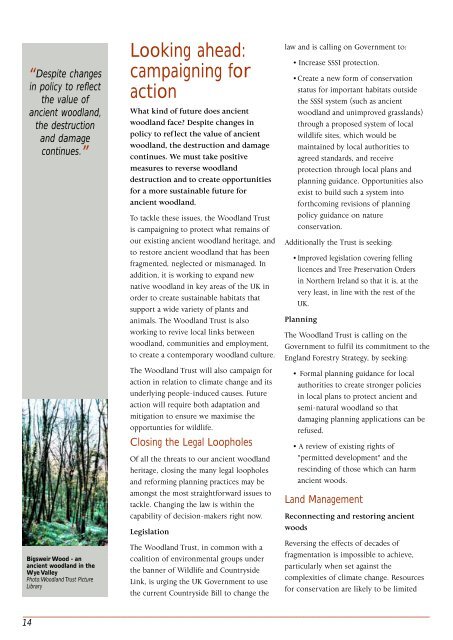Ancient Woodland Threats - Woodland Trust
Ancient Woodland Threats - Woodland Trust
Ancient Woodland Threats - Woodland Trust
You also want an ePaper? Increase the reach of your titles
YUMPU automatically turns print PDFs into web optimized ePapers that Google loves.
“ Despite changes<br />
in policy to reflect<br />
the value of<br />
ancient woodland,<br />
the destruction<br />
and damage<br />
continues.”<br />
Bigsweir Wood - an<br />
ancient woodland in the<br />
Wye Valley<br />
Photo:<strong>Woodland</strong> <strong>Trust</strong> Picture<br />
Library<br />
Looking ahead:<br />
campaigning for<br />
action<br />
What kind of future does ancient<br />
woodland face Despite changes in<br />
policy to reflect the value of ancient<br />
woodland, the destruction and damage<br />
continues. We must take positive<br />
measures to reverse woodland<br />
destruction and to create opportunities<br />
for a more sustainable future for<br />
ancient woodland.<br />
To tackle these issues, the <strong>Woodland</strong> <strong>Trust</strong><br />
is campaigning to protect what remains of<br />
our existing ancient woodland heritage, and<br />
to restore ancient woodland that has been<br />
fragmented, neglected or mismanaged. In<br />
addition, it is working to expand new<br />
native woodland in key areas of the UK in<br />
order to create sustainable habitats that<br />
support a wide variety of plants and<br />
animals. The <strong>Woodland</strong> <strong>Trust</strong> is also<br />
working to revive local links between<br />
woodland, communities and employment,<br />
to create a contemporary woodland culture.<br />
The <strong>Woodland</strong> <strong>Trust</strong> will also campaign for<br />
action in relation to climate change and its<br />
underlying people-induced causes. Future<br />
action will require both adaptation and<br />
mitigation to ensure we maximise the<br />
opportunties for wildlife.<br />
Closing the Legal Loopholes<br />
Of all the threats to our ancient woodland<br />
heritage, closing the many legal loopholes<br />
and reforming planning practices may be<br />
amongst the most straightforward issues to<br />
tackle. Changing the law is within the<br />
capability of decision-makers right now.<br />
Legislation<br />
The <strong>Woodland</strong> <strong>Trust</strong>, in common with a<br />
coalition of environmental groups under<br />
the banner of Wildlife and Countryside<br />
Link, is urging the UK Government to use<br />
the current Countryside Bill to change the<br />
law and is calling on Government to:<br />
• Increase SSSI protection.<br />
• Create a new form of conservation<br />
status for important habitats outside<br />
the SSSI system (such as ancient<br />
woodland and unimproved grasslands)<br />
through a proposed system of local<br />
wildlife sites, which would be<br />
maintained by local authorities to<br />
agreed standards, and receive<br />
protection through local plans and<br />
planning guidance. Opportunities also<br />
exist to build such a system into<br />
forthcoming revisions of planning<br />
policy guidance on nature<br />
conservation.<br />
Additionally the <strong>Trust</strong> is seeking:<br />
• Improved legislation covering felling<br />
licences and Tree Preservation Orders<br />
in Northern Ireland so that it is, at the<br />
very least, in line with the rest of the<br />
UK.<br />
Planning<br />
The <strong>Woodland</strong> <strong>Trust</strong> is calling on the<br />
Government to fulfil its commitment to the<br />
England Forestry Strategy, by seeking:<br />
• Formal planning guidance for local<br />
authorities to create stronger policies<br />
in local plans to protect ancient and<br />
semi-natural woodland so that<br />
damaging planning applications can be<br />
refused.<br />
• A review of existing rights of<br />
"permitted development" and the<br />
rescinding of those which can harm<br />
ancient woods.<br />
Land Management<br />
Reconnecting and restoring ancient<br />
woods<br />
Reversing the effects of decades of<br />
fragmentation is impossible to achieve,<br />
particularly when set against the<br />
complexities of climate change. Resources<br />
for conservation are likely to be limited<br />
14


